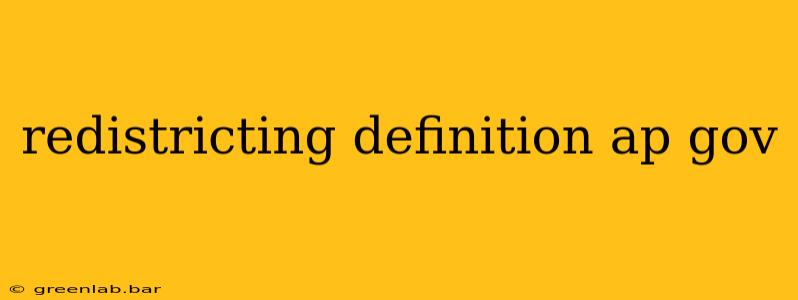Redistricting is a critical process in American politics, directly impacting the balance of power and representation at the state and national levels. Understanding its intricacies is crucial for anyone studying AP Government. This guide provides a comprehensive definition, explores the process, and highlights key legal challenges.
What is Redistricting?
Redistricting, in the context of AP Government, is the process of redrawing the boundaries of electoral districts. This happens after every decennial census, when the population of the United States is officially counted. The goal is to create districts with roughly equal populations, ensuring that each citizen's vote carries approximately the same weight. This principle is known as the "one person, one vote" principle, established through various Supreme Court cases.
Why is Redistricting Important?
Redistricting significantly impacts the composition of legislative bodies (like the House of Representatives and state legislatures). The way districts are drawn can determine who wins elections, influencing the political landscape for a decade. This makes it a high-stakes process, often subject to intense political maneuvering.
The Redistricting Process: Who's Involved?
The responsibility for redrawing district lines typically falls on state legislatures. However, the specifics vary from state to state. Some states have independent commissions responsible for redistricting, aiming to create a more objective and less politically biased process.
Regardless of who draws the lines, the process generally involves:
- Census Data: The decennial census provides the population data necessary to determine the number of people each district should represent.
- Political Considerations: It's unrealistic to deny that political considerations often heavily influence the drawing of district lines. This can lead to gerrymandering, a practice discussed in detail below.
- Legal Challenges: Redistricting plans are frequently challenged in court, particularly when accusations of gerrymandering are made. Judges will often consider whether the plan complies with the "one person, one vote" principle and other legal standards.
Gerrymandering: A Major Challenge in Redistricting
Gerrymandering is the deliberate manipulation of district boundaries to favor one party or group over another. There are two main types:
- Packing: Concentrating voters of a particular party into a single district to reduce their influence in other districts.
- Cracking: Dividing voters of a particular party among multiple districts to prevent them from forming a majority in any of them.
Gerrymandering can effectively disenfranchise voters, rendering their votes less impactful. This practice has become a major source of contention in American politics, and numerous legal challenges aim to limit its effects. The Supreme Court has addressed gerrymandering in several cases, but establishing clear legal standards remains a challenge.
The Impact of Redistricting on AP Gov Topics
Understanding redistricting is essential for grasping several key concepts in AP Government:
- Representation: Redistricting directly impacts the fairness and effectiveness of representation.
- Political Participation: Gerrymandering can discourage political participation by making certain voters feel their voice doesn't matter.
- Federalism: The balance of power between state and federal governments is reflected in the redistricting process, highlighting the complexities of federalism.
- Civil Rights: Redistricting challenges often involve claims of racial discrimination, underscoring the importance of civil rights in the electoral process.
Conclusion
Redistricting is a dynamic and politically charged process with far-reaching consequences. Understanding its definition, the process involved, and the challenges it presents is crucial for analyzing the American political system effectively. This is especially vital for succeeding in AP Government. The ongoing debate over gerrymandering highlights the continuous evolution of this critical aspect of American democracy.

